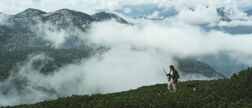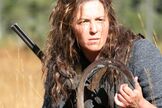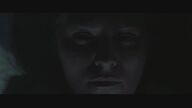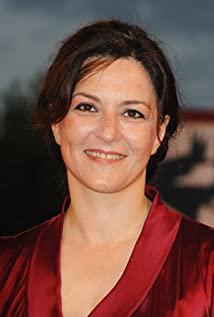Text / Jiang Xiaomao
2013-06-24
"Now sometimes I get lost in my own thoughts, as if the forest is beginning to take root in my heart Sprouting, with my brain, reciting its ancient and eternal mind. And then, in the second summer, I hadn't reached that point, and the boundaries between the external and the self were still very clear. Now I am writing I find it difficult to distinguish between the old self and the new self. The new self, I am not sure, is it slowly becoming a bigger one, us."
This female lead is near the end of the film. The monologue summed up the main line of the film just right, and for the question raised at the end of this passage, we can also answer affirmatively, "Yes". The film "Hidden Wall" is lonely, but it is not lonely for the sake of loneliness, but lonely for the sake of transcendence. Just as someone once said that only by knowing the pain of hunger can one experience the joy of a full meal, and only when one knows the taste of loneliness can one understand the value of companionship. Just being in a movie doesn't have to happen between people. On the contrary, "Hidden Wall" shows the possibility of dialogue between man and animals, nature and the soul within himself, and it shows a state of transcendence.
The narrative frame of the entire film of "Hidden Wall" is the confession of a woman who puts her experience in the past few years into pen and paper, and at the same time the picture unfolds before our eyes. The presentation method of the film is very special. There are only very few live dialogues in the whole film (more precisely, live monologues, because the language communication between people and dogs and calves can only be one-way), and the rest Parts are either pure visuals and soundtracks or natural sounds, or narration leads. It is worth mentioning that there has also been a small innovation in the relationship between the picture and the narration in "Hidden Wall". The narration no longer serves to explain the picture and promote the plot in one direction; on the contrary, the picture is more like a woman's memoir. dynamic illustrations.
The tone of The Hidden Wall is terrifying, even terrifying. This is partly a perfect match for the film's theme, because loneliness — the loneliness of total isolation, life or death — is terrifying. This kind of terrifying atmosphere permeates almost every frame of the magnificent picture, and when the heroine first touches the hidden wall, it is even more surprising. The background of the story is that the heroine, a man named Hugo, a woman named Louis and their hound Lux go to a small mountain village in northern Austria for vacation. The heroine and the hound, Luke, were alone in the hunting lodge, but they did not come back that night. The director used gloomy pictures and a terrifying soundtrack to give a close-up of the only winding mountain road into the village, implying an ominous arrival. The next day, the heroine and Lucas follow the road in search of Hugo and Louis. Lux's painless low-pitched howl completely awakened the previous horror close-up. Although the scene was sunny and beautiful, the atmosphere was terrifying, because the characters at this time were at the corner of the winding road, which we can't imagine. What will happen when you turn the corner?
Subsequently, the director used two camera perspectives. We first borrowed the perspective of Luke the Hound, curled up behind the heroine and dared not move forward, seeing her getting further and further away from us. As the heroine turns and moves forward, we are suddenly placed in front of her, and we see her progress come to an abrupt halt when she collides with an invisible object. At this point, the title of the film announces its own physical existence—the heroine hits an invisible wall.
For the heroine, a sense of terror also pervaded her whole body. She had no way of knowing how this invisible, terrifying thing could be on the road and how Hugo and Luis didn't come across it. What she couldn't understand was why the villagers were not curious about this phenomenon. The last question was quickly answered - because this is a valley of death, and the people in the valley are dead. She went back to the hidden wall again, touching this terrible thing with both hands. In the face of nature and unknown forces, people's power and cognition are so small, so the director also reduced the characters and enlarged the scene, and placed the characters in a corner of the picture, through this huge contrast to emphasize the position of the person extreme situation. And this is also a compositional feature of the film "Hidden Wall": people rarely dominate the picture; what dominates the picture is nature and some unknown mysterious force.
As mentioned earlier, this valley is the valley of death, and all the imagery associated with human society—trucks carrying logs, cabins—are separated by this invisible wall. Inside the wall, the lifting gear on the truck is repeating the mechanical inanimate movement endlessly, and the well in front of the log cabin keeps spewing fresh water, but the owner of the log cabin - an old couple who has passed away - forever still at some unknown point in time. As if death came too fast, they were beaten into wax statues before they had time to react, and before they had receded signs of life. These pictures are terrifying, even more terrifying than the pictures of complete silence, because the flowing water and the constantly moving lifting device are like a display of death, which writes the fear of death with the power of life, just as the film is accompanied by the portrayal of loneliness precious. This invisible wall is like an exhibition window, in which the heroine sees everything that might happen to her. How can this feeling of facing death through the window be not terrifying.
Compared with the old couple who were raided by death, the heroine's experience was even more tragic. Because Death seems to have decided to play a game with her that is already clear. The god of death would not suddenly come to seal her life, but gave her enough time to let her quench her desire for life in the collision of life and death. This collision of life and death is on the one hand physical and at the same time spiritual. In the huge paddock enclosed by the hidden wall, the heroine is not only accompanied by her pet dog, Luke, but also encounters a cow who is about to give birth and a tabby cat who is also about to give birth. Soon after, they both successfully gave birth to new lives. The heroine gave these animal companions human names, and their mutual dependence also made them feel like family. However, in order to survive, the heroine has to kill, she can only maintain her "small family" by frequently shooting wild deer, but in this valley of death, wild deer are also precious lives. This kind of physical life and death also gradually leads the heroine to think about the ultimate proposition of life and death. In the beginning, the desperate heroine was still able to maintain rationality, because she believed that "only thinking like a human can save death." But this kind of thinking becomes more and more absurd in the face of irresistible natural or supernatural forces, because this completely isolated existence has allowed the protagonist to slowly merge with the surrounding nature, in her own words, her ego "is slowing down" Slowly become a bigger us.” In the whole process of transformation, rationality is gradually being marginalized, and sensibility is gradually tending to dominate. For example, when a deer is in estrus in nature, the protagonist sleeps in his clothes at night, lying in bed listening to this irresistible sound of nature. The characters at this time only occupy one-ninth of the lower right corner of the screen, and the rest of the screen is mysterious, terrifying, and unexplorable darkness.
The film also shows the tragic death of the first wild deer that was shot, which seems to highlight the needless struggle of all living beings at the moment of death. The protagonist has a panoramic view of this whole process, and from this moment on, she has embarked on an endless spiritual struggle, because the deer's dying struggle is actually a replica of her current life. The frequent shooting of animals makes the protagonist sick, and her rationality almost collapses at this time. She can't imagine what those who take hunting for fun think, she can only hide in the cold bed and imagine the deer's heart that she dug out and has frozen into ice. She came to realize that people live in a way that defies nature; they become cruel and unlovable. Human "reason" condemns innocent beings to death. One can live without this. The heroine also grows up in a new, completely harmonious order.
However, the good times did not last long, and the appearance of humans broke the connection and balance that the protagonist had worked so hard to establish. A man suddenly breaks into the protagonist's summer pasture and kills the calf with an axe. Luke the Hound jumps up heroically to fight the man, and the protagonist runs back to the hut to get the gun. The director deliberately used slow motion for this sequence of action, and we followed the heroine back to the hut, waiting for her to reappear, to load, aim, and shoot. The purpose of this set of slow motion is to illustrate that everything is too late. The calf is dead, Lux is dying, and the protagonist's few dependencies in his life are suddenly gone. Ironically, the long-awaited human companion of the protagonist actually appeared as a cruel murderer and a god of death. He broke up this small family struggling to survive in a desperate situation, bringing a strong atmosphere of despair and death. This group of shots is interspersed with flashbacks of the present and the past. The heroine, who appears as a memoir writer, stares bravely at the camera. Her eyes are filled with all kinds of complicated emotions, perhaps sadness, shock to herself, and other emotions. There is fear of the future. The camera and the screen have also become part of the hidden wall in the film. The protagonist has a sincere eye contact with the audience through this wall, but this communication can only be one-way, because we cannot give the screen to the outside of the screen or the wall. She has enough courage to live inside/inside the wall.
At the end of the film, the protagonist's desperate survival continues, she is still working hard to eradicate weeds, trying to save a lifeline for the valley. But as the protagonist himself said, the dead are no more, and everything now is far from the end, everything is still moving forward. What the future holds, we don't know, but in the past, she suffered her fate with more dignity than ours.
View more about The Wall reviews









